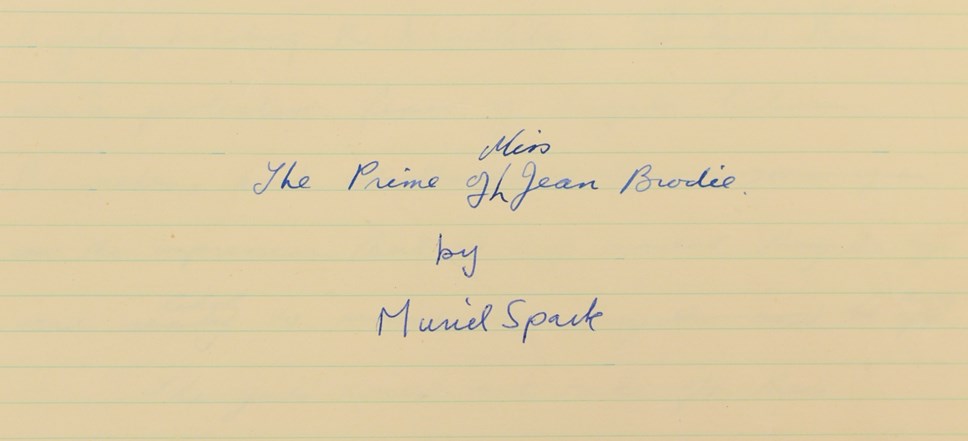
FROM POVERTY TO HER PRIME - MAJOR EXHIBITION REVEALS THE REAL MURIEL SPARK
Items never before seen by public are the "creme de la creme" of writer's amazing archive
The manuscript of one of Scotland’s most famous novels that was made into an Oscar-winning film has returned home to take pride of place in a free exhibition at the National Library of Scotland celebrating the life of Dame Muriel Spark.
The handwritten pages in four plain exercise jotters bought from James Thin’s bookshop in Edinburgh gave birth to one of the great characters of modern literature – Miss Jean Brodie in her prime.
It was written in Edinburgh in just four weeks in late 1960 and its publication the following year was to propel Spark to international success. Such is its significance that the manuscript is now owned by the University of Tulsa but it has been loaned to the National Library for the exhibition along with the manuscript of Spark’s own favourite novel, The Driver’s Seat.
The International Style of Muriel Spark opening tomorrow (December 8) at the National Library of Scotland features items never previously seen by the public, most of which are from Spark’s extraordinary personal archive held at the Library.
Among the items to be seen are
- Correspondence with some of the biggest names in 20th century literature including Graham Greene, Evelyn Waugh, Iris Murdoch, Doris Lessing, John Updike and Gore Vidal;
- A handwritten note from one of the world’s most famous women – Jacqueline Kennedy Onassis – offering to buy the worldwide rights to Spark’s auto-biography;
- Handbags and evening dresses worn by Spark along with invitations to glamorous events sent by presidents, royalty and leading socialites;
- Betting slips and correspondence relating to the racehorse she bought from the Queen;
- The portable typewriter she used for her poetry and reviews in the 1950s;
- A note signed by film star Elizabeth Taylor telling Spark that Taylor and her husband Richard Burton are “great fans”;
- A press release she wrote, promoting the idea of a film being made of her early life;
- Original examples of some of her earliest writing penned as a teenager in Edinburgh;
- The ration book from her penniless days in post war London when she struggled to make her way as a writer;
- Dozens of covers of foreign translations of her books;
- Her mother’s brass plaque advertising piano lessons that hung outside the family flat in Bruntsfield in Edinburgh.
Spark is regarded by many to be the most important Scottish writer since Sir Walter Scott and Robert Louis Stevenson. Although she lived the bulk of her life abroad she always said it was Scotland that formed her and she carried an unmistakable trace of her homeland in her speech all her days.
The exhibition looks at her life through the places she lived – Edinburgh, Rhodesia, London, New York, Rome and Tuscany. It charts her struggle to establish herself as a writer through to the international success that attracted the interest of Hollywood and saw her books published around the world.
Spark admitted to being a hoarder of two things – documents and trusted friends. She threw away very little and her archive, as well as containing literary riches, it is full of evidence of her everyday life – shopping receipts, old passports, used airline tickets and much more. No other author so deliberately and carefully preserved a record of their life. She even kept her science jotter from secondary school which can be seen in the exhibition.
One of Scotland’s most successful modern day novelists, Ian Rankin, whose own writing got in the way of him completing a PhD on Spark’s work, is to formally open the exhibition. He said: “An exhibition on Muriel Spark’s life and work is long overdue and it is time she was rightly recognised as one of our greatest ever writers, constantly inspired by Scotland and her upbringing in Edinburgh.”
The exhibition has been put together by Dr Colin McIlroy, the Library’s Muriel Spark Project Curator, who has spent the past two years immersed in the detail of the archive. Through that he has come to know the real Muriel Spark. “What comes through strongly from correspondence in the archive is a picture of a generous, fun loving individual which is not how she has always been portrayed. She did fall out with people and she knew how to stand up for herself but she comes across as a much warmer and caring person than perhaps I was expecting. She kept friends for decades and she was fiercely loyal. I hope this exhibition helps people to get a better understanding of the person behind the books.”
The exhibition is one of the main events in Muriel Spark 100, a year-long programme of activity to celebrate the centenary. It is organised jointly by the Library and Creative Scotland. Events already planned include the publication of new editions of all 22 of Spark’s novels; an international academic conference; a walking tour of the places that inspired her in Edinburgh; and an evening of readings, performances and storytelling featuring leading Scottish writers in Edinburgh’s Usher Hall in January organised by the Edinburgh International Book Festival.
The International Style of Muriel Spark runs from 8 December 8- 13 May at the National Library of Scotland, George IV Bridge, Edinburgh. Entry is free.
Contact Information
Notes to editors
The National Library of Scotland
The National Library of Scotland is a major European research library and one of the world’s leading centres for the study of Scotland and the Scots - an information treasure trove for Scotland’s knowledge, history and culture. The Library’s collections are of world-class importance. Key areas include digital material, rare books, manuscripts, maps, music, moving images, official publications, business information, science and technology, and modern and foreign collections. The Library holds more than 26 million physical items dating back over 1000 years in addition to a growing library of e-books, e-journals and other digital material. The collection includes over four million books, eight million manuscripts, two million maps and over 45,000 films and videos. Every week the Library collects around 3,000 new items. Most of these are received free of charge in terms of Legal Deposit legislation. www.nls.uk / @natlibscot /facebook
